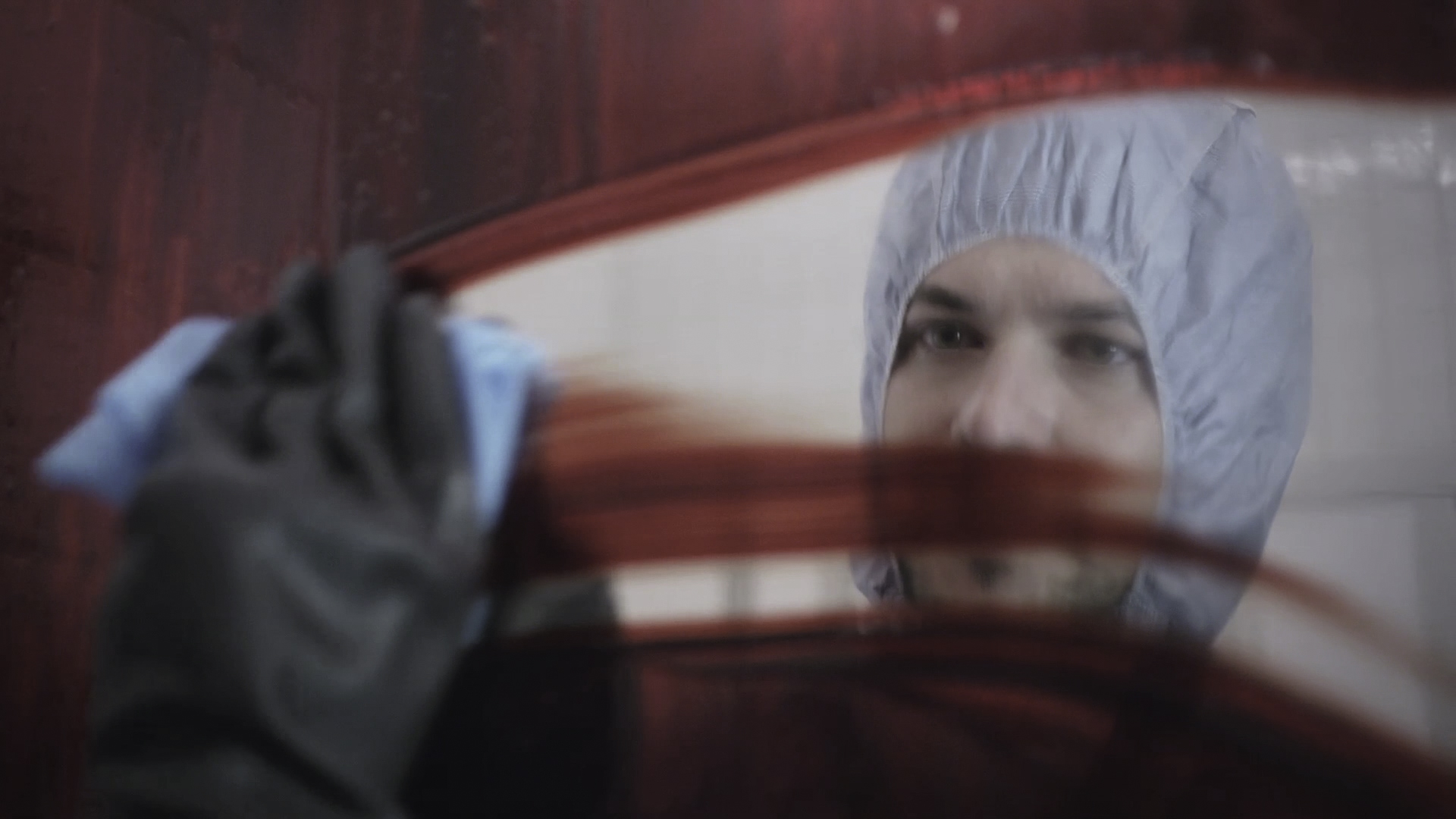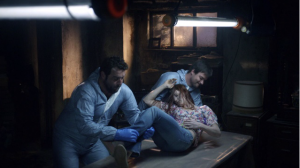 |
|
| GERSH •
LOS ANGELES bhalperin@gersh.com DENCH ARNOLD • LONDON mac@dencharnold.com |
|
| O-1 US Work Visa + Union, Fluent in French + Dutch |
| FILM + TV DRAMA |
|
CINEMATOG BLOG | |||
| COMMERCIALS | |||||
| CINEMATOG BLOG | |||||
| TRAVELS WITH MY CAMERA | |||||
| CONTACT | |||||
| “SPOTLESS”
Q and A Netflix July 2016. |
 “Spotless”
is a 10-part original series for Canal Plus, Esquire and Netflix,
Produced by Rola Bauer, Moritz Polter and Hugh Warren. The first two
episodes were directed by Pascal Chameil. It stars Marc-Andre Grondin,
Denis Menochet and Brendan Coyle. “Spotless”
is a 10-part original series for Canal Plus, Esquire and Netflix,
Produced by Rola Bauer, Moritz Polter and Hugh Warren. The first two
episodes were directed by Pascal Chameil. It stars Marc-Andre Grondin,
Denis Menochet and Brendan Coyle.What influenced the look of the series? ‘Spotless’ was written to compete with the big American thrillers. From the start, I approached the series as a hybrid modern noir. With director Pascal Chameil, we started by looking at Scandi TV and apart from the writing and bleak atmosphere, we were not that drawn by the production values or look. There was more relevance for us in series such as ‘True Detective’, ‘Broadwalk Empire’, Mr Robot and obviously as a starting point ‘Breaking Bad’. We were both huge fans of the work of Jacque Audiard and looked carefully at his mis-en-scene and the brutal but simple fight scenes in ‘A Prophet’. We consequently tried to keep our coverage visceral and paired down in all violent encounters. I also looked at the Coen Brothers “No Country for Old Men”. There is a rye humour to ‘Spotless’ and we were influenced by the treatment of the Anton Chigurh character. This psychotic killer is such an iconic baddy and we wanted Nelson Clay, (played brilliantly by Brendan Coyle) to have similar menace and constant danger. The Coens shoot him in side profile or well below the eyeline, with wide lenses, or very long lenses. We looked at the harshness of Nan Goldin’s photographs, the beauty, colour and noir sense of light in ‘In the Mood for Love’ and the photographs of Saul Leiter. Locations seem to play an important roll in this drama?  I
was generously given six weeks’ prep and it allowed me to work
very closely with director Pascal Chameil and designer Eve Stewart
in crafting the look of the series. It meant I could location scout
and not just come in late when the choices have largely been made
in design and costume. I
was generously given six weeks’ prep and it allowed me to work
very closely with director Pascal Chameil and designer Eve Stewart
in crafting the look of the series. It meant I could location scout
and not just come in late when the choices have largely been made
in design and costume.London was a key character in the film – the landscape and how we experienced London had to be through the eyes of an outsider. We did not want London to be presented as iconic or immediately recognisable, and yet we wanted to feel immersed in it. The dockland areas of Wapping and the East End became our key focus, as they had an atmosphere of counter culture. We also shot extensively in central London, which was quite a challenge and up and down the river. ‘Spotless’, at times was trying to straddle many camps – it was to be an American series, with strong European overtones, shot in the UK, with French actors who speak English to each other. There are obvious contradictions to some of this, but I hope that ‘Spotless’ does have its own definitive identity. The sense of family seems very important to the series?  Like
‘Breaking Bad’, family is what anchors Jean and what he
tries to protect. The house is a sanctuary of family life, but the
family are constantly under threat. Like
‘Breaking Bad’, family is what anchors Jean and what he
tries to protect. The house is a sanctuary of family life, but the
family are constantly under threat.Eve Stewart (production designer), came up with a shadowy lower basement living room and kitchen area with few windows and no views out, bar a small enclosed terrace at the back. The walls were dark green. I lit it with contrast and practical lights and tried to keep the sense of menace and ever present danger firmly rooted within the family home. This environment also seemed to echo Jean’s dark childhood. The childhood flashbacks were very poignant and a huge contrast to the London drama? We see flashbacks of their childhood, set in the La Rochelle area. It is a violent, dysfunctional and abusive upbringing, that seems to inform Jean and Martin’s adult lives. The boys are party to a manslaughter which Jean commits. I thought the psychology of the whole series was rather brilliantly charted by writer Ed McCardie. There is a bleak dereliction to this flat oyster-bed landscape. Littered with used shells, it evokes a sense of decay and is one of the poorest areas of France. It is a strong contrast to the urban metropolis of London and we were keen to play on the sense of space. We looked at the drawings of Van Gogh, set in a landscape where the sky is ¾ of the image. Figures drawn from behind, detached and isolated. The sea is always close by and a labyrinth of canals lead out to larger estuaries. I used Super Baltar lenses for this section. They have a more naturalistic and colder look and worked well in contrast with the more modern look of London. I tried to feature 70% sky in each shot and juxtapose wide lenses with very long telephoto lenses. Often we used only three or four shots for each flashback, and they needed to capture dramatic decisive moments. The children hardly speak, and when they do, it is in French which is subtitled. There is a sense of presence, amplified by the lack of dialogue. We tried to shoot from a child’s angle of view. All is shot from two feet off the ground – adults are all seen as threatening. We tried to use natural light – flares, strong sunlight, the aqua-marine colours of the sky and sea, the desaturated greys, browns and ambers of the landscape. We shot for two weeks north of La Rochelle during a cold but sunlit November. I thought Brendan Coyle as Nelson Clay, was terrifying.  Brendan
Coyle was a smoldering gentleman mobster – he is a brilliant
presence and a total loose canon. As previously stated, we looked
carefully at the ‘Anton’ character in “No Country
for Old Men”. Brendan
Coyle was a smoldering gentleman mobster – he is a brilliant
presence and a total loose canon. As previously stated, we looked
carefully at the ‘Anton’ character in “No Country
for Old Men”.I tried to light him in a half light – often with much harder light than our two hero’s. He has a chiseled face that I wanted to bring that out. Lighting him with hard light was the antithesis of his well known Downtown Abbey character. The ‘grand finale’ in episode ten, involves a lynching on a roof top. Brilliantly directed by Philip John, Nelson Clay reaches the epitome of evil and had us all quaking in our very cold boots on set. For it was mid December and we were outside on the seventh floor of a factory in the heart of the East End. We craned in lights, two 160KVA generators and a 50ft technocrane and shot over two nights -much of it stunt work. I tried to mix neon with sodium and half green/blue night light. It worked quite well and with a bit of desaturation gave us a strong colour pallet. I think we terrified the whole neighborhood with repeated gun shots, gang warfare and bodies being strung up. I gather that you posted in Prague? We posted in Prague at UPP on a baselight. Thomas Urbye from ‘The Look’ London, came out and did an initial pass on the first two episodes and then we carried on with the UPP team. They were very capable and talented. I tried to avoid there being a massive difference in grade between the flashbacks and London scenes. I wanted the movement from adult life to childhood to be seamless. The fact that we go from adult actors to childhood actors in a different landscape was enough. American TV is becoming darker and bolder and more cinematic by the day. If you look at such series at ‘Man in the High Castle’, and ‘Preacher’, they have very strong looks. ‘Spotless’ did not go as far as I hoped it would do but that is often the nature with a series that is screening on differing international platforms. I would have preferred a slightly darker and more committed look. Spotless was a great fun to shoot and I gather that another series is currently being written. “Spotless” is on Netflix from late July 2016 by Tony Miller |
||||
| IMDB Wikipedia Facebook Twitter | TONY
MILLER © 2024 |
||||